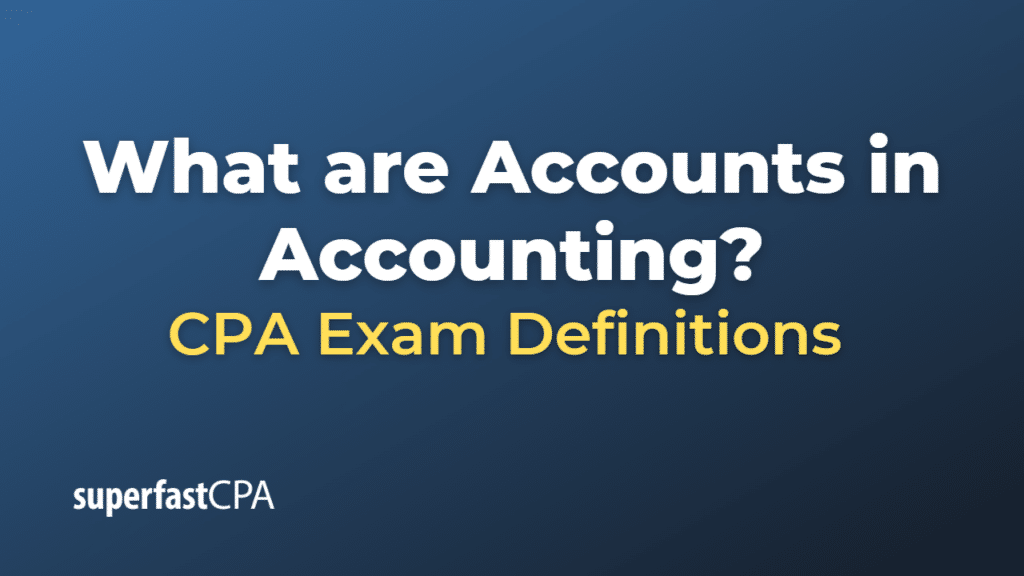Accounts
Accounts in accounting refer to individual record-keeping elements that track the financial activities and balances of specific assets, liabilities, equity, revenues, and expenses. Each account represents a unique aspect of a business’s financial position or performance, and together, they form the basis of the double-entry bookkeeping system used by most organizations.
Accounts are organized in the general ledger, which is a summary of all financial transactions for a specific period. Accounts are typically grouped into five main categories based on the accounting equation (Assets = Liabilities + Equity) and the components of financial statements:
- Assets: Assets are resources owned or controlled by a business that provide future economic benefits. Asset accounts include cash, accounts receivable, inventory, property, plant and equipment, and intangible assets like patents or trademarks.
- Liabilities: Liabilities are obligations of a business that result from past transactions and will require the transfer of resources in the future. Liability accounts include accounts payable, notes payable, accrued expenses, and long-term debt.
- equity: Equity, also known as owner’s equity or shareholder’s equity, represents the residual interest in the assets of a business after deducting liabilities. Equity accounts include common stock, retained earnings, and additional paid-in capital.
- Revenues: Revenues are amounts earned by a business from its regular operations, such as the sale of goods or services. Revenue accounts include sales revenue, service revenue, and interest income.
- Expenses: Expenses are costs incurred by a business in the process of generating revenues. Expense accounts include cost of goods sold, wages expense, rent expense, and depreciation expense.
Each account has a normal balance, either debit or credit, depending on the account type. In the double-entry bookkeeping system, every financial transaction impacts at least two accounts – one account is debited, and another account is credited. The total debits must always equal the total credits, maintaining the balance in the accounting equation.
Accounts in accounting help businesses organize and track their financial information, prepare financial statements, and ensure accuracy and compliance with accounting principles and regulations. They provide valuable insights into a company’s financial health and performance, supporting informed decision-making by management, investors, and other stakeholders.
Example of Accounts
Let’s consider a fictional small business called “Anna’s Art Supplies” to illustrate how accounts in accounting are used to record financial transactions.
Anna’s Art Supplies purchases $5,000 worth of inventory on credit from a supplier. This transaction affects two accounts:
- Inventory (Asset account)
- Accounts Payable (Liability account)
To record this transaction using the double-entry bookkeeping system, Anna’s Art Supplies would make the following journal entries:
- Debit Inventory (Asset) account: +$5,000
- Credit Accounts Payable (Liability) account: +$5,000
This journal entry increases the Inventory account by $5,000, reflecting the addition of new inventory, and increases the Accounts Payable account by $5,000, representing the obligation to pay the supplier in the future.
Later, Anna’s Art Supplies sells $2,000 worth of inventory for cash. This transaction impacts two accounts:
- Cash (Asset account)
- Sales Revenue (Revenue account)
To record this transaction, Anna’s Art Supplies would make the following journal entries:
- Debit Cash (Asset) account: +$2,000
- Credit Sales Revenue (Revenue) account: +$2,000
This journal entry increases the Cash account by $2,000, reflecting the receipt of cash from the sale, and increases the Sales Revenue account by $2,000, representing the revenue earned from the sale.
By using accounts to record and organize financial transactions, Anna’s Art Supplies can track its financial position, monitor its performance, and prepare accurate financial statements to inform business decisions and satisfy reporting requirements.













